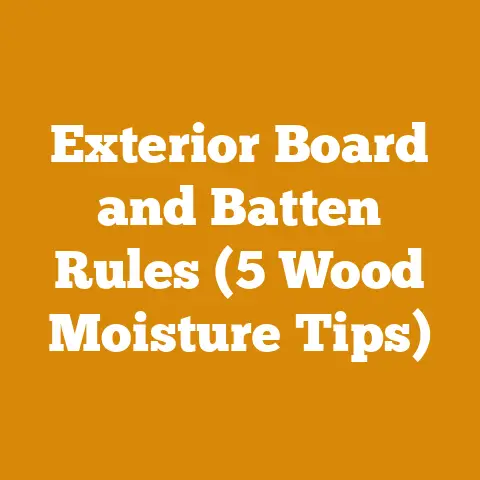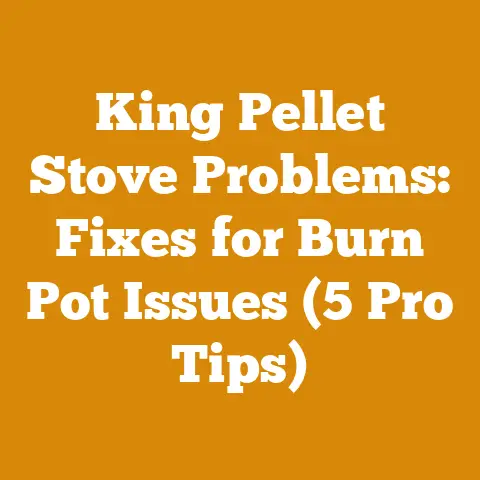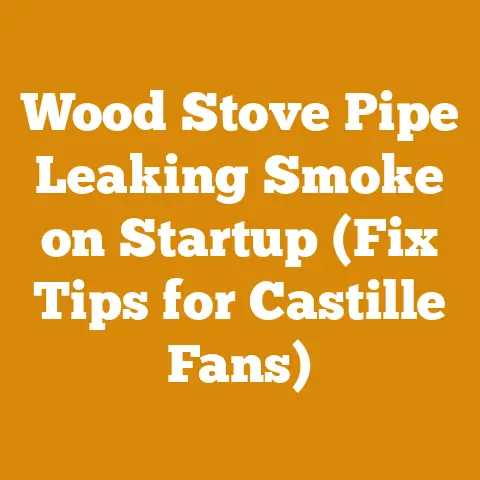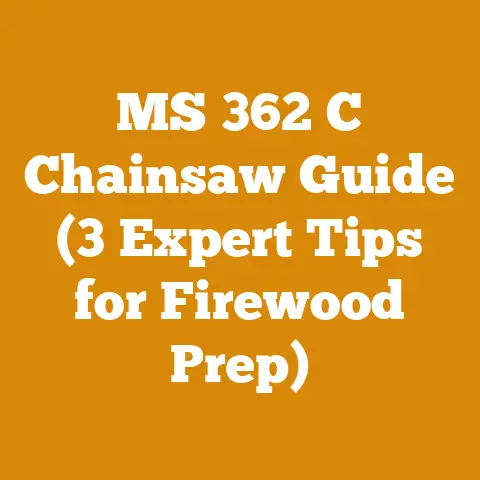Homemade Outdoor Wood Heaters (7 Expert Tips for DIY Boilers)
In an era where eco-conscious choices are no longer a trend but a necessity, the allure of homemade outdoor wood heaters has grown exponentially. For years, I’ve been immersed in the world of wood processing and logging, both professionally and as a passionate hobbyist. It’s not just about saving money; it’s about embracing a sustainable lifestyle and connecting with nature’s bounty. Let’s dive into the art and science of building your own efficient and safe outdoor wood boiler.
Homemade Outdoor Wood Heaters: 7 Expert Tips for DIY Boilers
Building your own outdoor wood boiler is a rewarding project that can significantly reduce your heating bills and carbon footprint. However, it requires careful planning, a solid understanding of thermodynamics, and adherence to stringent safety standards. I’ve compiled seven essential tips, drawing from my own trials and tribulations, research, and observations from countless projects across different continents.
1. Understanding the Fundamentals of Outdoor Wood Boilers
Before you even think about welding or plumbing, it’s crucial to grasp the basic principles of how an outdoor wood boiler operates. These systems, sometimes called outdoor wood furnaces, are essentially water-jacketed stoves that burn wood to heat water. This hot water is then circulated through insulated underground pipes to your home, where it transfers heat via radiators, baseboard heaters, or radiant floor systems.
- Heat Transfer: The efficiency of your boiler hinges on effective heat transfer from the fire to the water. This is where the design of the firebox and water jacket becomes critical.
- Thermostatic Control: A thermostat is essential for regulating the fire and maintaining a consistent water temperature. Without it, you risk overheating the system, wasting fuel, and potentially causing damage.
- Insulation: Proper insulation is vital to minimize heat loss both in the boiler itself and in the underground pipes connecting it to your home.
- Water Quality: Maintaining the correct water chemistry is crucial to prevent corrosion and scale buildup inside the boiler. Regular water testing and treatment are necessary.
2. Designing Your Boiler: Size and Specifications
The size of your boiler depends on the size of your home, its insulation levels, and the climate you live in. A boiler that’s too small won’t provide enough heat, while one that’s too large will cycle on and off frequently, reducing efficiency and lifespan.
- Heat Load Calculation: The first step is to calculate your home’s heat load. This is the amount of heat (measured in BTUs per hour) required to keep your home at a comfortable temperature during the coldest days of the year.
- You can use online calculators or consult with a heating professional to determine your heat load.
- Factors to consider include square footage, insulation R-values, window types, and climate zone.
- Boiler Sizing: Once you know your heat load, you can size your boiler accordingly. A general rule of thumb is to add a safety factor of 20% to your heat load to account for variations in wood quality and weather conditions.
- Example: If your heat load is 50,000 BTU/hr, you’ll need a boiler with a minimum output of 60,000 BTU/hr.
- Firebox Volume: The firebox volume determines how much wood you can load at once. A larger firebox means less frequent refueling.
- Rule of Thumb: Aim for a firebox volume that can hold enough wood to burn for at least 8-12 hours during peak heating season.
- Water Jacket Volume: The water jacket volume affects the boiler’s thermal inertia. A larger water jacket provides a more stable water temperature but takes longer to heat up.
- Consideration: A good balance is essential. Too little water, and the temperature fluctuates wildly; too much, and the system is slow to respond to demand.
- Material Selection: The materials you use to build your boiler must be able to withstand high temperatures and pressures.
- Steel: Use high-quality steel with a minimum thickness of ¼ inch for the firebox and water jacket. A36 steel is a common and cost-effective choice.
- Welding Rods: Use welding rods specifically designed for high-temperature applications, such as E7018.
3. Sourcing Materials and Tools: The Right Equipment for the Job
Building an outdoor wood boiler requires a significant investment in materials and tools. While it’s tempting to cut corners to save money, it’s crucial to use high-quality components to ensure safety and longevity.
- Steel: As mentioned earlier, use high-quality steel with a minimum thickness of ¼ inch for the firebox and water jacket.
- Insulation: Choose a high-temperature insulation material with a low thermal conductivity. Mineral wool or ceramic fiber insulation are good options.
- R-Value: Aim for an R-value of at least R-19 for the boiler insulation.
- Piping: Use PEX-AL-PEX (cross-linked polyethylene with an aluminum layer) for the underground pipes connecting the boiler to your home. This type of pipe is durable, flexible, and resistant to corrosion.
- Insulation: Insulate the underground pipes with a closed-cell foam insulation to minimize heat loss.
- Circulation Pump: Select a high-efficiency circulation pump that’s sized appropriately for your system.
- Head Pressure: Consider the head pressure required to overcome the friction in the pipes and radiators.
- Thermostat: Use a digital thermostat with a remote sensor to accurately control the water temperature.
- Safety Valves: Install pressure relief valves and temperature relief valves to prevent overpressure and overheating.
- Tools: You’ll need a variety of tools, including a welder, plasma cutter, angle grinder, drill, pipe bender, and various hand tools.
- Welder: A MIG welder is a good choice for welding steel. Ensure you have proper safety equipment, including a welding helmet, gloves, and respirator.
- Plasma Cutter: A plasma cutter is useful for cutting steel plates.
- Angle Grinder: An angle grinder is essential for grinding welds and preparing surfaces.
My Personal Experience: I once tried to save money by using cheaper steel for a boiler project. It didn’t end well. The steel warped and cracked after a few months of use, and I had to rebuild the entire boiler. Lesson learned: quality materials are worth the investment.
4. Welding and Fabrication: Precision is Key
Welding is arguably the most critical aspect of building an outdoor wood boiler. Poor welds can lead to leaks, structural failures, and even explosions.
- Preparation: Thoroughly clean and degrease all surfaces before welding.
- Welding Technique: Use proper welding techniques to ensure strong, leak-proof welds.
- Penetration: Ensure adequate penetration of the weld into the base metal.
- Overlap: Avoid excessive overlap, which can create stress points.
- Welding Order: Follow a specific welding order to minimize warping and distortion.
- Tack Welds: Start with tack welds to hold the pieces in place.
- Skip Welding: Use skip welding to distribute heat evenly.
- Inspection: Carefully inspect all welds for cracks, porosity, and other defects.
- Dye Penetrant Testing: Consider using dye penetrant testing to detect surface cracks.
- Pressure Testing: After welding, pressure test the boiler to ensure it’s leak-proof.
- Hydrostatic Testing: Fill the boiler with water and pressurize it to 1.5 times the operating pressure.
Safety Note: Always wear proper safety equipment when welding, including a welding helmet, gloves, and respirator.
5. Plumbing and Electrical Connections: Ensuring Safe and Efficient Operation
The plumbing and electrical connections are just as important as the welding and fabrication. Incorrectly installed components can lead to leaks, electrical hazards, and system malfunctions.
- Piping Connections: Use proper fittings and sealants to ensure leak-proof connections.
- Thread Sealant: Use Teflon tape or pipe dope on threaded connections.
- Compression Fittings: Use compression fittings for copper and PEX tubing.
- Electrical Wiring: Follow all applicable electrical codes when wiring the boiler.
- Grounding: Properly ground all electrical components.
- Overcurrent Protection: Use circuit breakers or fuses to protect against overcurrent.
- Circulation Pump Wiring: Wire the circulation pump to a thermostat or timer to control its operation.
- Safety Controls: Install safety controls, such as pressure relief valves and temperature relief valves, to prevent overpressure and overheating.
- Water Treatment: Install a water treatment system to prevent corrosion and scale buildup.
- Water Softener: Use a water softener to remove minerals that can cause scale buildup.
- Corrosion Inhibitors: Add corrosion inhibitors to the water to protect against corrosion.
6. Insulation and Weatherproofing: Protecting Your Investment
Insulation and weatherproofing are essential to minimize heat loss and protect the boiler from the elements.
- Boiler Insulation: Insulate the boiler with a high-temperature insulation material, such as mineral wool or ceramic fiber insulation.
- R-Value: Aim for an R-value of at least R-19 for the boiler insulation.
- Piping Insulation: Insulate the underground pipes with a closed-cell foam insulation to minimize heat loss.
- Burial Depth: Bury the pipes at least 2 feet below the frost line to prevent freezing.
- Weatherproofing: Protect the boiler from the elements with a weatherproof enclosure.
- Roof: Build a roof over the boiler to protect it from rain and snow.
- Siding: Install siding around the boiler to protect it from wind and sun.
- Ventilation: Provide adequate ventilation to prevent moisture buildup inside the enclosure.
7. Safety and Maintenance: A Long-Term Commitment
Building an outdoor wood boiler is a significant undertaking, but it’s only the beginning. Regular maintenance and adherence to safety protocols are essential to ensure safe and efficient operation for years to come.
- Safety Inspections: Conduct regular safety inspections of the boiler and its components.
- Leak Checks: Check for leaks in the plumbing and piping.
- Electrical Checks: Check for loose wires and damaged components.
- Pressure Relief Valves: Test the pressure relief valves to ensure they’re functioning properly.
- Cleaning: Regularly clean the firebox and chimney to remove creosote buildup.
- Creosote: Creosote is a flammable substance that can cause chimney fires.
- Frequency: Clean the chimney at least once a year, or more often if necessary.
- Water Treatment: Regularly test the water and add chemicals as needed to maintain proper water chemistry.
- pH Levels: Maintain the pH level within the recommended range.
- Corrosion Inhibitors: Add corrosion inhibitors to protect against corrosion.
- Wood Storage: Store wood in a dry, well-ventilated area to prevent rot and mold.
- Moisture Content: Use seasoned wood with a moisture content of less than 20%.
- Emergency Plan: Develop an emergency plan in case of a fire or other malfunction.
- Fire Extinguishers: Keep fire extinguishers nearby.
- Emergency Contacts: Know the phone numbers of your local fire department and emergency services.
Data Point: According to the National Fire Protection Association (NFPA), heating equipment is the second leading cause of home fires in the United States. Proper installation, maintenance, and operation are crucial to prevent fires.
Wood Selection Criteria: Fueling Your Boiler Efficiently
The type of wood you burn significantly impacts the efficiency and lifespan of your outdoor wood boiler. Hardwoods generally burn hotter and longer than softwoods, but they also take longer to dry.
- Hardwoods vs. Softwoods:
- Hardwoods: Oak, maple, ash, and beech are excellent choices for firewood. They have a high density and BTU content.
- BTU Content: Oak, for example, has a BTU content of approximately 27 million BTU per cord.
- Softwoods: Pine, fir, and spruce are less desirable for firewood due to their lower density and higher resin content. They tend to burn quickly and produce more smoke and creosote.
- Creosote Production: Pine can produce up to three times more creosote than hardwoods.
- Hardwoods: Oak, maple, ash, and beech are excellent choices for firewood. They have a high density and BTU content.
- Moisture Content: The moisture content of your firewood is critical. Burning wet wood reduces efficiency, increases creosote buildup, and produces more smoke.
- Ideal Moisture Content: Aim for a moisture content of 15-20% for optimal burning.
- Seasoning Time: Seasoning firewood typically takes 6-12 months, depending on the type of wood and climate.
- Measurement: Use a moisture meter to accurately measure the moisture content of your firewood.
- Log Dimensions: The size of your logs should be appropriate for the size of your firebox.
- Diameter: Logs should be no larger than 6-8 inches in diameter.
- Length: Logs should be slightly shorter than the length of your firebox.
- Storage: Store firewood in a dry, well-ventilated area to prevent rot and mold.
- Stacking: Stack firewood in a way that allows for good air circulation.
- Covering: Cover the top of the woodpile to protect it from rain and snow.
Tool Calibration Standards: Ensuring Precision and Accuracy
Accurate tool calibration is essential for safe and efficient wood processing. Chainsaws, moisture meters, and other tools should be calibrated regularly to ensure they’re functioning properly.
- Chainsaw Calibration:
- Chain Tension: Maintain proper chain tension to prevent kickback and ensure efficient cutting.
- Tension Check: The chain should be snug against the bar but still able to be pulled around by hand.
- Carburetor Adjustment: Adjust the carburetor to ensure proper fuel-air mixture.
- Idle Speed: Adjust the idle speed to prevent the chain from spinning when the saw is idling.
- Chain Sharpening: Sharpen the chain regularly to maintain its cutting efficiency.
- Sharpening Angle: Use the correct sharpening angle for your chain type.
- Chain Tension: Maintain proper chain tension to prevent kickback and ensure efficient cutting.
- Moisture Meter Calibration:
- Calibration Check: Use a calibration block to check the accuracy of your moisture meter.
- Adjustment: Adjust the meter as needed to ensure accurate readings.
- Measuring Tools:
- Tape Measures: Check the accuracy of tape measures regularly.
- Levels: Ensure levels are properly calibrated before use.
Safety Equipment Requirements: Protecting Yourself from Injury
Working with wood and building an outdoor wood boiler can be dangerous. It’s essential to wear proper safety equipment to protect yourself from injury.
- Personal Protective Equipment (PPE):
- Eye Protection: Wear safety glasses or goggles to protect your eyes from flying debris.
- Hearing Protection: Wear earplugs or earmuffs to protect your hearing from loud noises.
- Gloves: Wear work gloves to protect your hands from cuts and abrasions.
- Steel-Toed Boots: Wear steel-toed boots to protect your feet from heavy objects.
- Chainsaw Chaps: Wear chainsaw chaps to protect your legs from chainsaw injuries.
- Hard Hat: Wear a hard hat to protect your head from falling objects.
- Fire Safety Equipment:
- Fire Extinguishers: Keep fire extinguishers nearby.
- Smoke Detectors: Install smoke detectors in your home.
- Carbon Monoxide Detectors: Install carbon monoxide detectors in your home.
- First Aid Kit: Keep a well-stocked first aid kit on hand.
Case Study: A Small-Scale DIY Boiler Project
I once helped a friend build a small-scale outdoor wood boiler for his workshop. His workshop was 800 square feet, poorly insulated, and located in a region with harsh winters. After calculating his heat load, we determined that he needed a boiler with an output of approximately 30,000 BTU/hr.
- Design: We designed a simple, rectangular boiler with a firebox volume of 8 cubic feet and a water jacket volume of 50 gallons.
- Materials: We used ¼-inch A36 steel for the firebox and water jacket, mineral wool insulation, and PEX-AL-PEX tubing for the underground pipes.
- Construction: We welded the boiler together using a MIG welder and pressure tested it to ensure it was leak-proof.
- Installation: We buried the underground pipes 2 feet below the frost line and insulated them with closed-cell foam insulation.
- Results: The boiler performed well, providing ample heat for his workshop. He was able to significantly reduce his heating bills and eliminate his reliance on propane.
Technical Details:
- Heat Load Calculation: 30,000 BTU/hr
- Firebox Volume: 8 cubic feet
- Water Jacket Volume: 50 gallons
- Steel Thickness: ¼ inch
- Insulation R-Value: R-19
- Pipe Burial Depth: 2 feet






